Shoei J Cruise 2 helmet review
Published on: 11 March 2020
CLICK SHOEI J-CRUISE HELMET TO SHOP WITH FREE UK NEXT DAY DELIVERY
It was in 2013 that Shoei first introduced the world to its J-Cruise helmet. It replaced a helmet called the J-Wing that had, in turn, been in the Shoei range for many years. But, for 2020, Shoei has improved and updated the J-Cruise with an upgraded model called, somewhat unimaginatively, the J-Cruise 2.
But the motorcycle world is fast changing, and today the bike park is full of the kinds of bikes that were unheard of 10 years ago. Which begs various questions as to whether the J-Cruise is still a relevant style. What exactly is the J-Cruise? Who wears one? And why? What kind of bike do the people who buy the J-Cruise ride? And how and when do they ride those bikes?
These seem to us to be valid questions because helmets like this and the Schuberth M1 are hybrids that are difficult to categorise and pigeon hole. Clearly, a helmet like the J-Cruise falls short when it comes to considerations of safety and protection. Obviously, such helmets are going to provide greater protection from the elements than a traditional, café racer style, open-face helmet, but in an accident you cannot expect the external visor to provide much by way of physical protection as far as the face and chin are concerned. In fact, there’s a scenario in which a broken visor could even exacerbate injuries.
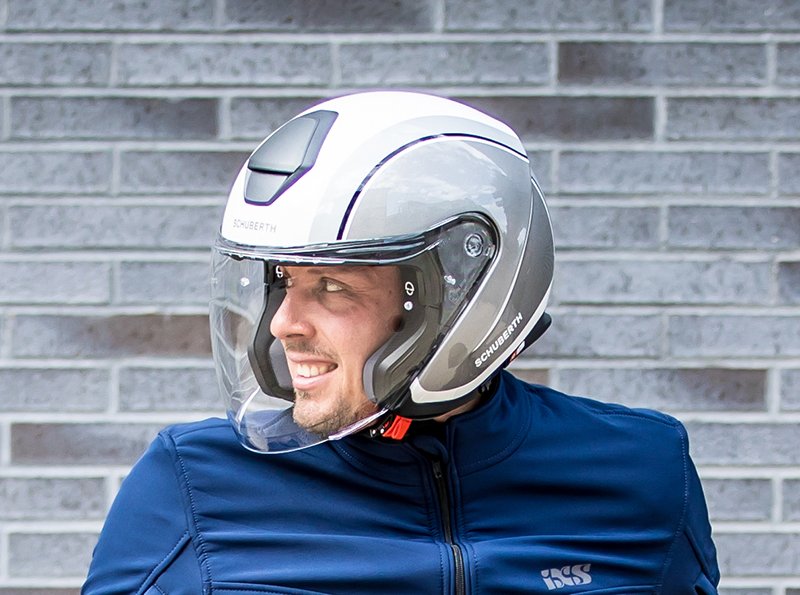
We understand, of course, that most motorcyclists understand the risks they are taking whenever they throw a leg over a bike, and that we all have different attitudes to risk. For me, personally, I’m prepared to wear an open-face helmet only when I deem the danger threshold to be low; when I’m riding locally, when I know that I won’t be on the bike for that long, and when I know that I won’t be exceeding, say, 50 mph. If these conditions don’t apply, then I’ll only put my faith in a full-face helmet.
Of course, some who ride in open-face helmets simply have not contemplated the dangers involved in their headwear choice. It’s possible that some lack the imagination to recognise the potential consequences of an accident. For others, of course, a classic, open-face, café-racer style of helmet is a statement; a fashion statement, perhaps. And we have no issue with this. Dressing up, these days, is part of biking. And most of us will acknowledge that considerations of style have played at least some part in the way that we dress for the bike.

But a helmet like the J-Cruise is scarcely a fashion statement. It is not a trendy style of helmet, and helmets like these are not bought by fashionistas. It is, we would suggest, a helmet for those who fully recognise and acknowledge the risks they are taking by wearing an open-face helmet. We are talking about the kind of biker for whom a full-face helmet represents almost an attack on their sense of personal liberty. These riders are prepared to trade the inherently increased risk for the wind in your face feeling that a full-face helmet simply cannot provide.
These people tend not to ride sportsbikes. Nor are they part of the hipster brigade, for whom an authentic look is sacrosanct. Commuters, other than those who ride almost exclusively in the urban environment, would not usually wear a helmet like the J-Cruise. And clearly you wouldn’t wear a helmet of this type off road.
We are aware that some people like to tour in helmets like this. They are also popular with some of those who ride cruisers. And we do often see riders of high capacity scooters in them. To wear a helmet like the J-Cruise is, once again, to make a statement. It is to raise a finger to conventional wisdom, to declare that whatever the logical reasons for not wearing an open-face helmet, the wearer wishes to assert the right to ride a motorbike in the manner that he or she wishes.
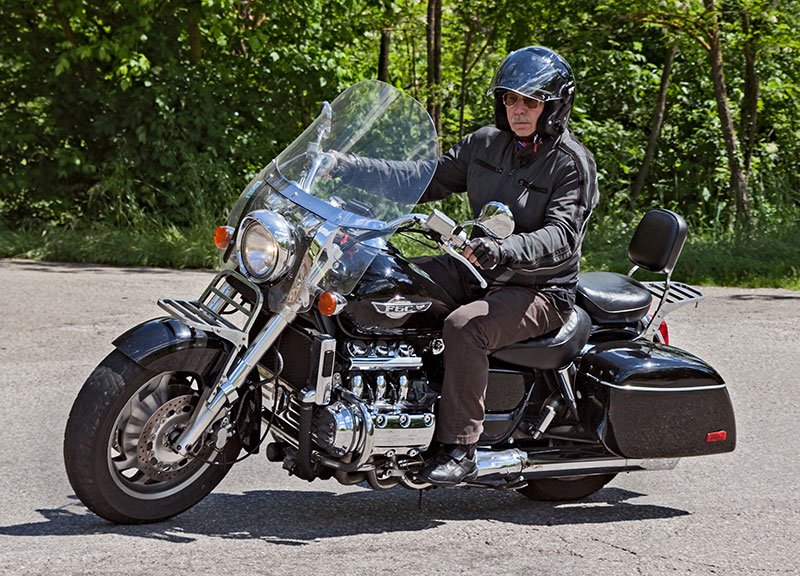
And, politically incorrect as it might be, we fully support the right of any biker to make such a choice. We cannot be so sanguine when we see people riding their sportsbikes in shorts and flip flops. By and large these people are simply dim. But the people who buy a J-Cruise are not dim. They are grown ups who know what they are doing, and they are prepared to face the consequences of their actions.
There was nothing wrong with the original J-Cruise, and there still isn’t. But time waits for no helmet manufacturer. Technologies change, materials improve, customer demands do not stand still. Recognising all these factors, Shoei set about improving the J-Cruise. And as is often the case in such circumstances, the new product does not differ markedly from its predecessor, although it is still the case that the J-Cruise 2 is undoubtedly an improvement in just about every respect.
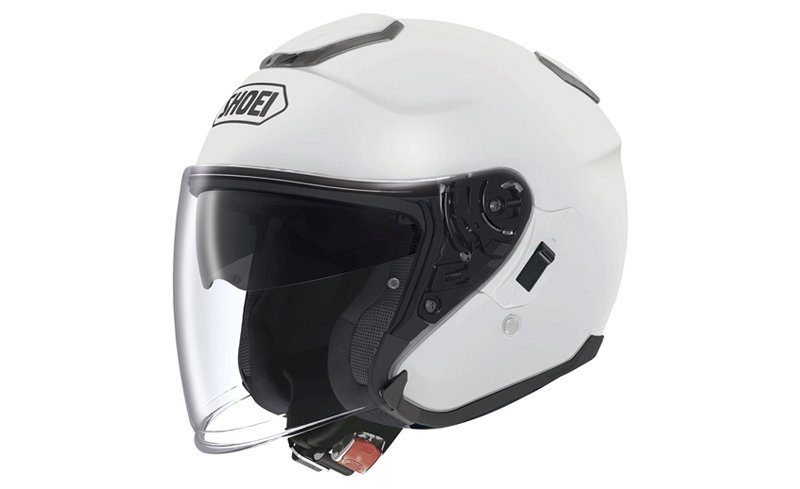
Whilst visually very similar to its predecessor, the new helmet features a totally new shell. The design of the shell has a bearing on almost every aspect of the helmet’s functionality, but to the casual observer all that can be discerned is slightly more compactness and a differently profiled rear end that now acts more as a spoiler. But the new shell, apparently, contributes to the helmet generating less lift and drag. It also makes a contribution to the fact that with the new helmet there’s a 43% reduced yaw effect at speed, (sideways pull).
What is unchanged is that the J-Cruise still uses Shoei’s multi-composite AIM shell. Also unchanged, in concept, is an eps with different densities in different parts of the helmet.
Shoei will tell you about the differences between the softer fabrics and the more moisture-absorbing fabrics that are used on the internal surfaces of the new helmet. And about how the lower edges now look more like real leather. But all that really interests us is that you can still change both the headlinings and the cheekpads to help improve the fit.
The drop-down sun visor is now deeper than it was on the old J-Cruise. And, fascinatingly, we are told that the cut-out for the nose is also 5mm deeper. But the most interesting change in and around the internal visor is that Shoei has reduced the depth of the cavity into which the visor recesses in order to reduce noise.
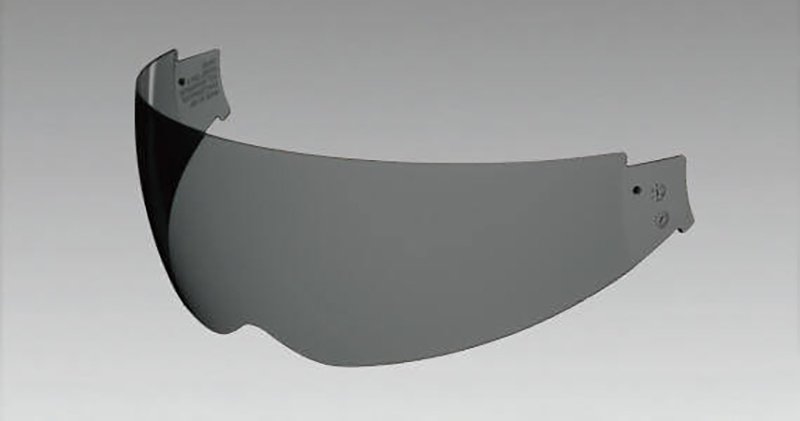
The new CJ-2 visor is, of course, grade one optical quality. And it now has a thicker bottom edge to reduce buffeting. In truth, misting up doesn’t tend to be a major issue on helmets like this. Indeed, the J-Cruise 2 is one of the very few Shoei helmets that does not come with a Pinlock in the box. In reality, all you normally need to do to demist a helmet like this is raise your head a little. The incoming air tends to immediately eradicate any condensation. But, even so, Shoei has built into the new helmet a ‘crack’ position that effectively does the same job.
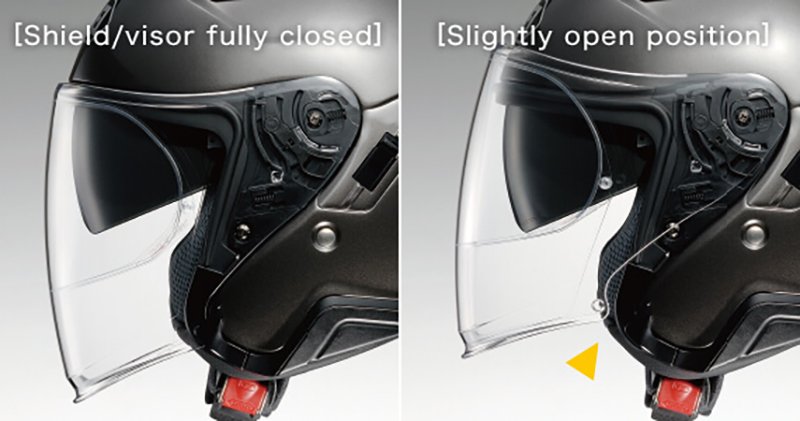
The visor locks down into position when riding, but you simply push on the lower left edge to release it. Historically, Shoei has often used a double-lip construction to seal the visor to the helmet, but on the J-Cruise 2, they have introduced an airtight window beading, which they claim is far more effective. There weren’t really many problems on the original J-Cruise, but let’s not be difficult; better is better.
Getting air onto the face in a J-Cruise is not, as we have suggested, a great challenge, but keeping the head cool is always important, and so, on the new helmet, an extra air intake increases airflow by 30%, whilst wind tunnel work on the top outlet has allowed up to 20% more air to be exhausted from the helmet.
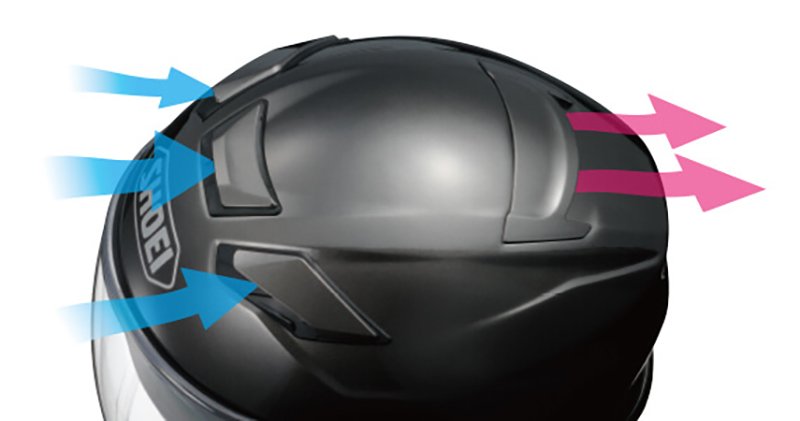
One of the most visible changes to the new J-Cruise 2 is that it’s now configured to take Sena’s SRL comms. system, as already fitted to the Neotec 2 and GT Air 2. (This is not the same system as fitted to the new Shoei Neotec 3 which takes the SRL-03). Based on the Sena 20 unit, it’s a state of the art package. There’s no unsightly box on the side, and the boom mike is so discrete as to be barely noticeable.
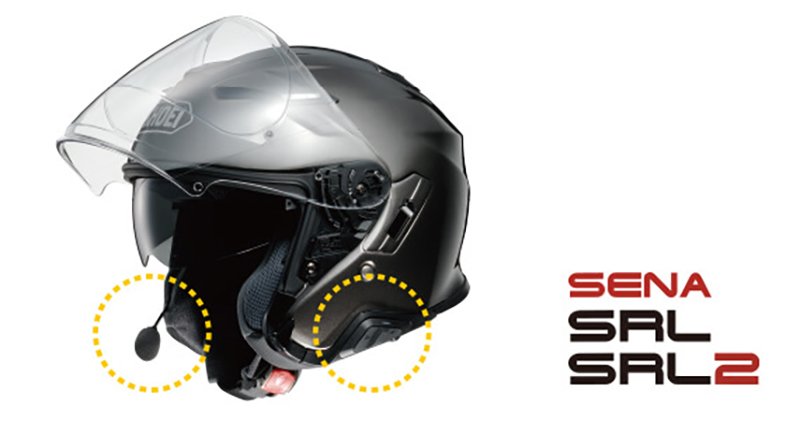
Most of the other stuff that there is to talk about would come under the heading of detail. A ratchet system for the strap. Four shell sizes. Six actual sizes. Three different thicknesses of headliner per size. Three different thicknesses of cheekpad. And so on.
The old J-Cruise was a great helmet. Clearly, the expectation is that the new model will be even better. Shoei doesn’t tend to mess up when they bring out a new helmet. Evolution rather than revolution tends to ensure that forwards is always the direction of travel.
But for us at Motolegends, the issue on any helmet is always fit. If a helmet fits properly, if the fitting has been professionally conducted, and if the helmet fits the way it should fit then you will have a great experience with your J-Cruise 2. But, even today, there are not many retailers who know how to professionally fit a helmet. There are even fewer who can be bothered. And fewer again who carry all the internals to enable the job to be done. On the J-Cruise 2 alone a dealer would need to hold more than 20 different lining pads. And very few dealers want to do so.
All we would say is that there’s no point in spending a lot of money on a premium quality helmet like a Shoei if it fits poorly. You might as well save money, and buy a cheaper helmet. A helmet that is too generous in its fit in either the cheeks or the forehead will move around and can block your vision. A generous helmet will be less quiet and will not do its job properly from a protection perspective. A helmet that is too tight can cause headaches, will exacerbate condensation issues, and will likewise not do its job properly from a protection perspective.
If you want to make sure you get the fit right on your J-Cruise 2, we recommend that you come to see us in Guildford. Here at Motolegends, we will always hold in stock the J-Cruise in all sizes, although not necessarily in all its colourways, although if ever we are out of stock of a design it can normally be obtained the next working day. And, of course, we will always carry the internal liners.
Finally, price. The J-Cruise costs £429.99 in white, but you can pay up to £519.99 for the most complex graphics. The SRL comms. costs £259.99, but you will save 20%, (£43), if you buy it at the same time as the helmet.
We do not, by and large, clutter the market with promotions, special deals, loyalty discounts and voucher codes. But our 10% Price Beat guarantee means that we will always be 10% cheaper than anybody who discounts any product we sell. And it seems to us that you cannot be fairer than that!
For more information and to order online, click Shoei J-Cruise 2 helmet.
Want some more? Please click here to return to our editorial menu.
Share this story
































































